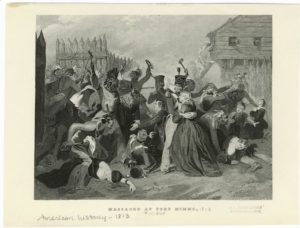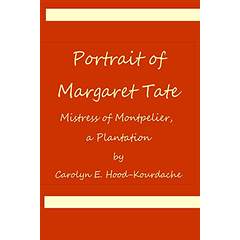In Portrait of Margaret Tate, Mistress of Montpelier, a Plantation, a biographical and historical sketch of the
daughter and heir of Choctaw metis, Reuben Dyer, is presented.
Reuben Dyer died before the events of August 30, 1813. In fact, he was not enumerated in the 1810 Mississippi Territorial Census. His widow, Mary Dyer, on the other hand, was killed at Fort Mims. Her son-in-law, [William] Theophilus Powell, represented her estate, as reported in Lackey’s Frontier Claims in the Lower South.
 Massacre at Fort Mimms, 1813. Courtesy of the New York Public Library, Digital Collections.
Massacre at Fort Mimms, 1813. Courtesy of the New York Public Library, Digital Collections.
Margaret Dyer’s Lineage
Richard Cussins = Choctaw maiden Dyer = Choctaw maiden
| |
Mary Cussins = Reuben Dyer
___________|________________
| |
Margaret Dyer Martha [Polly] Dyer
= 1. William Theophilus Powell = John Weatherford
___________|___________________________________
| | |
Mary D. Wm. Th. Jr. Martha
= David = Mary = Jason
Moniac Bryant Staples
= 2. David Tate
|
Josephine Bonaparte Tate
= James Denny Dreisbach
Powell’s three children and heirs were Mary Delphine, Martha, and William Theophilus Powell.i Dyer and David Tate had only one child together, Josephine Bonaparte Tate [James D. Dreisbach]. Although AmerIndian, Dyer responded to interrogatories at the Weatherford v. Weatherford, et al. trial, that she did not speak the Creek language, nor was she familiar with Creek lore and culture relating to marriage.ii Considering that she was Choctaw and not Creek, her responses were plausibly truthful. However, when we consider her treatment of Flora, we note that she was disengenuous.
According to George Stiggins, it was customary for Creek men to marry the female relative of their deceased wife. Tate legally married his second wife or concubine, Penny Coleman, another EuroIndian, in June of 1814, at Mobile, within a year of Mary Louise Randon’s death at Fort Mims. Unavailable Margaret Dyer-Powell, did not spark his attentions until well after the death of Coleman in 1817, the wartime death of William Powell, and the purchase of another concubine, “Flora,” in 1819. It was also customary to have multiple “wives.”
iTheophilus Powell, Last Will and Testament, May 17, 1816, Monroe County, Alabama, Orphans Court Record of Orders Book No. 1. 1816-1821. FHL# 1548209.
iiParedes, J. Anthony and Knight, Red Eagle’s Children, Weatherford vs. Weatherford, et al. (Contemporary American Indians) Hardcover – October 16, 2012.
© 2016 – 2022 All rights reserved.
